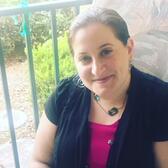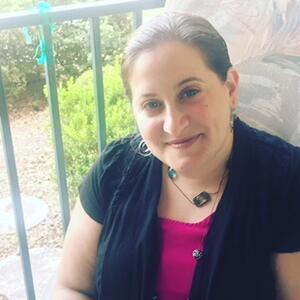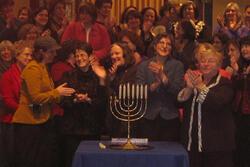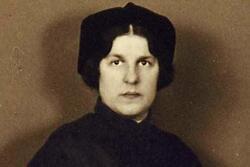The First
I had been waiting for the question.
It’s been public knowledge for months now: I am headed to Cape Town, South Africa, to join their rabbinic team as the congregation’s (and Cape Town’s) first female rabbi in a full-time congregational position. As you can imagine, this has led to many different questions about many different things. Why leave Toronto? Why Cape Town? Am I worried about security? Water? Being so far from home? The list goes on and on. And certainly, it includes many questions about being “the first.” And yet, I announced that I was taking the position in April and it is practically August when the other shoe finally drops.
The mother of an old friend is the one who finally says it out loud: “I guess you’ll have to be very careful about what you wear.” And there it is. More a statement than a question, but I’m ready for it. Because I’ve been thinking about it a lot. Since October, when it came up in my first round of interviews. (“We’re excited about the possibly of hiring our first full-time female clergy member. We think we’re ready for it.”) Since February, when I spent my first Shabbat in Cape Town and couldn’t help but notice the excitement on the faces of the women and girls in the congregation as they swarmed over to meet me. Not that the men in the congregation weren’t also pleased to meet me, but it was notably different. Unspoken and unmistakable.
It was the young girls I met that weekend who really made me pause and begin to think about it in a new way. About being a “first.” When I learned that the community was open to hiring a woman rabbi for the first time, I did some polling of other women rabbis to help me prepare for the inevitable questions that would come throughout (and hopefully after) the interview process. What should I be thinking about? Aware of? What challenges were likely to be ahead of me? I was fortunate to get many responses to my queries. I took note and I took notes (copious, copious notes). It would be fair to say that Temple Israel wasn’t the only one who thought they were ready. I thought so too—in the way that you can only think you are ready. You can never really know. Even as I write this, I don’t know. Am I ready? Am I up to it? Am I worthy of this honour and responsibility—being “the first”?
But that wasn’t the question I was asking myself when I was greeted so enthusiastically by the young girls in Cape Town that first Shabbat. Those girls reminded me of myself when I met my first female rabbi, Rabbi Sheryl Nosan, who wasn’t the first woman rabbi I had ever met, but was the first one to serve the temple where I grew up. While I certainly was and remained fond of our senior rabbi, there was something really special about the arrival of a woman rabbi to our community. I was bat-mitzvah-age and impressionable (and a bit of a nerd, to be quite honest), and my friends and I, enthusiastic and participating Shabbat and holiday “regulars,” were curious and excited about her. As the daughter of a rabbi, most rabbis didn’t impress me in and of their being rabbis, but I felt differently about Rabbi Nosan. I was eager to be close with her; to connect to her in a way that I hadn’t wanted to connect with rabbis prior to that. I related to her. She felt accessible in a way that male rabbis did not.
The memory of what Rabbi Nosan’s arrival meant to me struck me as I felt the eyes of Temple Israel’s young girls upon me. If all went well, I would become their first woman rabbi. And that excited me in a way that the more general “the first woman rabbi” phrase did not. What would that mean for them? And what would that mean for me?
And so, I started to think about the “first” women rabbis I have known and read about, much more than I ever did when I was in rabbinic school, surrounded by women in a class where the female-to-male ratio was oft discussed. I never aspired to be a “first” woman rabbi. I grew up in the 1980s. I thought of my mother as a feminist, but I didn’t think of myself as one (though I do now). I was a white, well-educated, upper/middle-class Canadian kid from the suburbs, with all the privilege each of those pieces entails. I was told that I could be anything that I wanted to be and do anything that a man could do, and I never had reason to question either statement until I actually became a rabbi and learned that it simply isn’t that simple. As I pursued my career as a rabbi, I was aware that the experience of male and female rabbinical students was different, but I had no idea how much it would impact the early years of my rabbinate, and I certainly never thought I would be the “first woman rabbi” anywhere. If you had told me that I would be actively pursuing a job where that was the case (let alone a job on the other side of the planet), I would not have believed you.
But as I began to think about “first” women rabbis and what kind of “first” woman rabbi I wanted to be, I felt a disconnect. I had trouble finding “first” women rabbis I could relate to. I am not a first-generation woman rabbi (in North America). I haven’t had the same challenges that they’ve had, and I haven’t had to prove myself in the same ways during the same eras as they had to. So I don’t dress like a first-generation rabbi and I don’t act like one. I am notably informal. I don’t wear pantsuits, and the only time I wore my hair short was the time I shaved it all off in a fundraiser for pediatric cancer research. I recognize that these are some gross stereotypes, but I hope you’ll understand why they’re necessary here, in this context, and forgive me for them.
The fact is, I’ve worked intentionally to create a different kind of rabbinate for myself. A rabbinate where I look and sound like most other people because, as I so often find myself reminding others, “rabbis are people too.” And it works. So many individuals and couples whom I’ve taught and worked with over the years have commented on this approach and reflected its success back to me. I believe that my generation needs rabbis they can relate to. More than that, I believe they crave it, as I craved a close connection with Rabbi Nosan all those years ago. Not because I lacked for rabbis in my life (trust me, I did not), but because I lacked for rabbis who were like me.
So that was my answer, back in February, when I asked myself the real question, the question that no one else has asked me explicitly: What will it look like for ME, Emma Gottlieb, to be a “first” woman rabbi? And it’s really very simple. The “first female rabbi in a full-time congregational position in Cape Town” will not look and sound like other women rabbis. She will look and sound like me, because I am her. And because the only way I can authentically answer the question is to just keep being me; keep being the rabbi I already am (and am proud to be). Which, for the record, does not mean that I will not concern myself with what I wear. Because all women rabbis do (or at least most do). Because we still get comments that male rabbis do not get. And because I’m short and curvy and I look about 10 to 15 years younger than I am, and none of that helps when you are trying to convince someone that you are, in fact, a rabbi and that you can, in fact, capably, beautifully and meaningfully lay their loved one to rest.
So, my suitcases are not packed with pantsuits but they are packed. And I think I’m ready, but I won’t really know until I get there. Or until I look back years from now and laugh at all the challenges and blessings I had no idea were coming my way. But I do know what kind of rabbi I am, and I know that I will soon get to see what it means to be the kind of rabbi I already am AND to be “the first.” The former is not going to intentionally change to be the latter. But being the latter will inevitably change and shape the former, and I can’t wait to see how that turns out.
Cape Town, here I come!
Kein Yehi Ratzon. Be it God’s Will.








Kol HaKavod and keep teaching your Torah!
In reply to Kol HaKavod and keep teaching by Rabbi Karen Fox
You go, Girl! Yasher kokheh.